Home » Strategic Enrolment Management
Category Archives: Strategic Enrolment Management
Meeting the International Student Enrolment Challenge with Enhanced International Student Engagement
Canada has seen a 29% increase in international students attending higher educational institutions, from 2022 to 2023, which has followed a 63% growth over the previous five years and more than 200% over the last decade (CBIE, 2023). This, however, is changing. Universities Canada (The Canadian Press, 2024) reports that enrolment of international students fell in 2024, in some cases by more than 50%, below the international student visa cap set by the federal government. Given this trend, we must ensure academic success and beneficial, appropriate, and resourceful study conditions for the international students studying at our institutions. One of the best ways of doing this is by enhancing international student engagement. In this blog, I introduce this topic and discuss ways we can all increase the engagement of international students in our classrooms.
International student engagement is international students’ active, ongoing effort to navigate and mediate the expectations and practices of their new academic environment (Kettle, 2017; Zimmerman, 2021). This concept views engagement as a social practice, where students interact with and respond to various elements such as actions, interactions, objects, values, expectations, and language. It emphasizes the students’ roles as active participants and experts in their own educational experiences, highlighting their strategies to adapt, succeed, and contribute to their academic and social environments. International scholarship on teaching and learning research shows that when international students feel connected and supported, they are more likely to dive into classroom activities, perform better academically, and build positive relationships with classmates and instructors (Freeman et al., 2014; Glass et al., 2015), and that engagement in the classroom is the strongest predictor of cognitive development for international students (Grayson, 2008).

Four interrelated types of engagement occur during learning activities, including behavioural, emotional, cognitive, and agentic engagement (Christenson et al., 2012). Behavioural engagement has been defined as participation in various activities (Finn, 1989), students’ positive effort, attention, and involvement in school (Skinner et al., 2009), and adaptive and maladaptive behaviour (Martin, 2010). Emotional engagement is generally conceptualized as comprised of positive and negative feelings toward school, teachers, and peers (Fredericks et al., 2004). Cognitive engagement has been described as beliefs and values about the importance of school and learning (Appleton et al., 2008; Martin, 2007) and self-regulation, strategy use, goals, and exerting effort (Martin, 2007). Agentic engagement is when individuals try to actively enrich their learning experiences and take responsibility for them (Reeve & Tseng, 2011).
Sense of belonging in a higher-educational setting significantly impacts the engagement of international students (Cena et al., 2021; Glass et al., 2015). Previous studies have shown that international students report a lower sense of belonging than native students (Strayhorn, 2012; Van Horne et al., 2018), and that the type and amount of extracurricular/social involvement are related to the sense of belonging (Bowman et al., 2019; Maestas et al., 2007), with more frequent participation in extracurricular activities increasing the sense of belonging to the institution (Thies & Falk, 2023). International students who feel integrated into the university community through meaningful interactions are more likely to participate in social activities (Glass et al., 2015).
Engagement is also affected by students’ unwillingness to communicate, which is the long-term tendency to avoid and/or devalue verbal communication (Kadi & Madini, 2019). Several factors related to anxiety have been identified, including concerns that limited English-speaking proficiency can inhibit clarity (Aksak & Cubucken, 2020; Horwitz et al., 1986), fear of being humiliated (Chichon, 2019; Wen & Cle ́ment, 2010), lack of self-confidence (Kadi & Madini, 2019; Saadat & Mukundan, 2019), anxiety over potential errors (Kang, 2005), instructors’ excessive emphasis on grammar (Wen & Cle ́ment, 2003; Woodrow, 2006), and place of origin (Woodrow, 2006). Several motivation and related factors have been identified as engagement influencers, including personality (Hz, 2022; Mohammadian, 2013), discussion topic (Kang, 2005; Zhou et al., 2021), grade evaluation approach (Zhou et al., 2021), family support (Aksak & Cubucken, 2020; Aydin, 2017), and socialization demands (MacIntyre et al., 1998).
Institutional policies and practices, such as inclusive teaching practices, culturally sensitive curricula, and opportunities for social interaction, play a pivotal role in fostering student engagement (Glass et al., 2015). Instructors can engage in strategies to enhance in-class communication, including shaping a positive classroom environment that can relax international students and reduce their anxiety (Smith et al., 2019; Zhou et al., 2021), developing workloads appropriate for international students (Zhou et al., 2021), adopting collaborative teaching approaches (Lee et al., 2019; Saadat & Mukundan, 2019; Zhou et al., 2021), involving students in peer teaching (Freemen et al., 2015; Yamauchi et al., 2016), engaging in problem-based learning to encourage students to solve real-world problems in collaborative settings (Freemen et al., 2015; Yamauchi et al., 2016), using group discussions for students to articulate their understanding, ask questions, and learn from their peers (Freemen et al., 2015; Yamauchi et al., 2016), preparing before class to expand their knowledge of students’ cultural backgrounds and traditions (Riasati, 2012; Zhou et al., 2021), conducting warm-up activities at the beginning of class (Zhou et al, 2021), applying supportive practices (Kinsella, 1997; Smith et al., 2019), and using culturally-responsive teaching methods (Gay, 2010; Zhou et al., 2017).
So, while we could lament the current decrease in international student enrolment facing most Canadian post-secondary educational institutions, there is much we can and should do to increase international student engagement leading to higher levels of success for those students able to enrol at our institutions despite the current regulatory approach to cap international student enrolments.
References:
Aksak, K., & Cubukcu, F. (2020). An exploration of factors contributing to students’ unwillingness to communicate. Journal for Foreign Languages, 12(1), 155-170. https://doi.org/10.4312/vestnik.12.155-170
Appleton, J. J., Christenson, S. L., & Furlong, M. J. (2008). Student engagement with school: Critical conceptual and methodological issues of the construct. Psychology in the Schools, 45(5), 369-386.
Aydın, F. (2017). Willingness to communicate (WTC) among intermediate-level adult Turkish EFL learners: Underlying factors. Journal of Qualitative Research in Education, 5(3), 1–29. https://doi.org/10.14689/issn.2148-2624.1.5c3s5m
Bowman, N, A., Jarratt, L., Jang, N., & Bono, T. J. (2019). The unfolding of student adjustment during the first semester of college. Research in Higher Education, 60(3), 273-292. https://doi.org/10.1007/s11162-018-9535-x
Canadian Bureau of International Education (2023). International students in Canada, https://cbie.ca/infographic/
Cena, E., Burns, S., & Wilson, P. (2021). Sense of belonging and intercultural and academic experiences among international students at a university in Northern Ireland. Journal of International Students, 11(4), 812-831. https://www.ojed.org/index.php/jis/article/view/2541
Chichon, J. (2019). Factors influencing international students’ willingness to communicate (WTC) on a pre-sessional programme at a UK university. Journal of English for Academic Purposes, 39, 87-96.
Christenson, S. L., Reschly, A. L., & Wylie, C. (Eds.). (2012). Handbook of Research on Student Engagement. Springer Nature. https://link.springer.com/content/pdf/10.1007/978-3-031-07853-8.pdf
Finn, J. D. (1989). Withdrawing from school. Review of Educational Research, 59, 117 – 142.
Freeman, S., Eddy, S. L., McDonough, M., Smith, M. K., Okoroafor, N., Jordt, H., & Wenderoth, M. P. (2014). Active learning increases student performance in science, engineering, and mathematics. Proceedings of the National Academy of Sciences, 111(23), 8410-8415.
Gay, G. (2010). Culturally responsive teaching: Theory, research, and practice. Teachers College Press.
Glass, C. R., Kociolek, E., Wongtrirat, R., Lynch, R. J., & Cong, S. (2015). Uneven Experiences: The Impact of Student-Faculty Interactions on International Students’ Sense of Belonging. Journal of International Students, 5(4), 353-363. https://files.eric.ed.gov/fulltext/EJ1125097.pdf
Grayson, J. P. (2008). The experiences and outcomes of domestic and international students at four Canadian universities. Higher Education Research & Development, 56, 473-492.
Horwitz, E. K., Horwitz, M. B., & Cope, J. (1986). Foreign language classroom anxiety. The Modern language journal, 70(2), 125-132. https://doi.org/10.1111/j.1540-4781.1986.tb05256.x
Hz, B. I. R. (2022). Exploring students’ public speaking anxiety: introvert vs extrovert. Journal of English Language Studies, 7(1), 107–120. https://jurnal.untirta.ac.id/index.php/JELS/article/view/14412/8831
Kadi, R. F., & Madini, A. A. (2019). Causes of Saudi students’ unwillingness to communicate in the EFL classrooms. International Journal of English Language Education, 7(1), 51. https://doi.org/10.5296/ijele.v7i1.14621
Kettle, M. (2017). International student engagement in higher education: Transforming practices, pedagogies and participation (pp. 5, 09-11, 13, 12, 11). Multilingual Matters. https://eprints.qut.edu.au/103570/22/103570.pdf
Kinsella, K. (1997). Creating an enabling learning environment for non-native speakers of English. In A. I. Morey, & M. K. Kitano (Eds.), Multicultural course transformation in higher education: A broader truth (pp. 104-125). Allyn and Bacon.
Lee, J. S., & Lee, K. (2019). The role of self-efficacy, task value, and learning goal orientation in willingness to communicate in a second language. Journal of Multilingual and Multicultural Development, 40(2), 140-156.
Lee, J. S., Lee, K., & Chen Hsieh, J. (2019). Understanding willingness to communicate in L2 between Korean and Taiwanese students. Language Teaching Research, 26(3), 455-476. https://doi.org/10.1177/1362168819890
Macintyre, P. D., Clément, R., Dörnyei, Z., & Noels, K. A. (1998). Conceptualizing willingness to communicate in a l2: A situational model of l2 confidence and affiliation. The Modern Language Journal, 82(4), 545–562. https://doi.org/10.1111/j.1540-4781.1998.tb05543.x
Maestas, R., Vaquera, G. S., & Zehr, L. M. (2007). Factors impacting sense of belonging at a Hispanic-serving institution. Journal of Hispanic Higher Education, 6(3), 237-256. http://doi.org/10.1177/1538192707302801
Martin, A. J. (2007). Examining a multidimensional model of student motivation and engagement using a construct validation approach. British Journal of Educational Psychology, 77, 413-440. http://dx.doi.org/10.1348/000709906X118036
Mohammadian. T. (2013). The effect of shyness on Iranian EFL learners’ language learning motivation and willingness to communicate. Theory and Practice in Language Studies, 3(11), 2036-2045. https://doi.org/10.4304/tpls.3.11.2036-2045
Reeve, J., & Tseng, C. M. (2011). Agency as a fourth aspect of students’ engagement during learning activities. Contemporary Educational Psychology, 36(4), 257-267. https://doi.org/10.1016/j.cedpsych.2011.05.002
Riasati, M. J. (2012). EFL learners’ perception of factors influencing willingness to speak English in language classrooms: A qualitative study. World Applied Sciences Journal, 17(10).
Saadat, U., & Mukundan, J. (2019). Perceptions of willingness to communicate orally in English among Iranian PhD students. International Journal of Applied Linguistics and English Literature, 8(4), 31-44. https://doi.org/10.7575/aiac.ijalel.v.8n.4p.31
Skinner, S., Kindermann, T., & Furrer, C. (2009). A Motivational Perspective on Engagement and Disaffection Conceptualization and Assessment of Children’s Behavioral and Emotional Participation in Academic Activities in the Classroom, Educational and Psychological Measurement, 69(3), 493-525.
Smith, C., Zhou, G., Potter, M., & Wang, D. (2019). Connecting Best Practices for Teaching Linguistically and Culturally Diverse International Students with International Student Satisfaction and Student Perceptions of Student Learning, Advances in Global Education and Research Volume 3 (James, W. B., & Cobonoglu, C., Eds.), pp. 252-265. Association of North America Higher Education International.
Strayhorn, T. L. (2012). Sentido de pertenencia: A higherarchical analysis predicting sense of belonging among Latino college students. Journal of Hispanic Higher Education, 7(4), 30-320. https://doi.org/10.1177/1538192708320474
The Canadian Press (2024, August 30). International student enrolment drops below federal cap: Universities Canada. National Post. Retrieved from https://nationalpost.com/news/canada/international-student-enrolment-drops-below-federal-cap-canada?taid=66d1bed289440d0001d0b514&utm_campaign=trueanthem&utm_medium=social&utm_source=twitter
Thies, T., & Falk, S. (2023). International students in higher education: Extracurricular activities and social interactions as predictors of university belonging. Research in Higher Education, 2023. https://doi-org.ledproxy2.uwindsor.ca/10.1007/s11162-023-09734-x
Van Horne, S. V., Lin, S., A. M., & Jacobson, W. (2018). Engagement, satisfaction, and belonging of international undergraduates at U.S. research universities. Journal of International Students, 8(1), 351-374. https://doi.org/10.32674/jis.v8i1.169
Wen, W. P., & Clément, R. (2003). A Chinese conceptualisation of willingness to communicate in ESL. Language, Culture and Curriculum, 16(1), 18–38. https://doi.org/10.1080/07908310308666654
Woodrow, L. (2006). Anxiety and speaking English as a second language. RELC Journal, 37(3), 308–328. https://doi.org/10.1177/0033688206071315
Yamauchi, L. A., Taira, K., & Trevorrow, T. (2016). Effective instruction for engaging culturally diverse students in higher education. International Journal of Teaching and Learning in Higher Education, 28(3), 460-470.
Zhou, G., Liu, T., & Rideout, G. (2017). A study of Chinese international students enrolled in the master of education program at a Canadian university. International Journal of Chinese Education, 6(2), 210-235. https://doi.org/10.1163/22125868-12340081
Zhou, G., Yu, Z., Rideout, G., & Smith, C. (2021). Why don’t they participate in class? In V. Tavares (Ed.), Multidisciplinary Perspectives on International Student Experience in Canadian Higher Education (pp. 81-101). IGI Global, https://doi.org/10.4018/978-1-7998-5030-4.ch005
Zimmermann, J., Falk., S., Thies, T., Yildirim, H. H., Kercher, J., & Pineda, J. (2021). Spezifische Problemlagen und Studienerfolg internationaler Studierender [Specific challenges and study success of international students]. In M. Neugebauer, H.-D. Daniel, & U. Wolter (Eds.): Studienerfolg und Studienabbruch (pp.179–202). Springer VS. https://doi.org/10.1007/978-3-658-32892-4_8
SEM and Systems Thinking
Christine Kerlin (2008) wrote that “Enrolment management is a comprehensive and coordinated process that enables a college or university to identify enrolment goals that are allied with its mission, its strategic plan, its environment, and its resources, and to reach those goals through effective integration of administrative processes, student services, curriculum planning and market analysis” (p.11). It is a holistic process that plays out across the student learning journey from inquiry to graduation. And its fundamental premise is that we must look at our enrolment health and sustainability throughout the entire student experience as we link, integrate, and extend enrolment management across our campuses.
Each of us has a role in developing and sustaining the SEM ecosystem on campus. We need to engage in shared responsibility. If SEM reflects institutional identity and culture, it becomes an institution-wide strategy owned by each member of the community. This is best achieved through lateral communication where open and frequent communication becomes part of the culture. Hossler, Bean, and associates (1990) said it well when they wrote “The more people involved in decision making, the greater the commitment to implementing the decision” (p. 35).
One of the best ways to do this is to adopt a systems thinking approach. Peter Senge (2006) described systems thinking as “…a discipline for seeing wholeness rather than parts, for seeing patterns of change rather than static snapshots, and for understanding the subtle interconnectedness that gives living systems their unique character” (pp. 68-60). Systems thinking allows SEM practitioners to create a fully embedded enrolment management system that engages campus leadership, faculty, the SEM steering committee, and operational working groups. We have long known that enhanced integration and participation of all key campus stakeholders is a necessary pathway to achieving enrolment management effectiveness on our campuses (Smith, 2000).
If you want to learn more about SEM and systems thinking, consider joining me for the “Systems Thinking is the Key to SEM Success” pre-conference workshop at this year’s SEMM Forum in Toronto on Tuesday, November 7th, from 9:00 a.m. to 12:00 p.m, at the Mariott Downtown at Toronto Eaton Centre. In this workshop, participants will learn and discuss the basics of systems thinking and how institutions can introduce and support the implementation of an enrolment management ecosystem.
-Clayton Smith
References:
Hossler, D., Bean, J. & Associates (1990). The strategic management of college enrollments. Jossey-Bass.
Kerlin, C. (2008). A community college roadmap for the enrollment management journey. College and University, 83(4), 10-14.
Senge, P. M. (2006). The fifth discipline: The art and practice of the learning organization. Doubleday. https://www.seeing-everything-in-a-new-way.com/uploads/2/8/5/1/28516163/peter-senge-the-fifth-discipline.pdf
Smith, C. (2000). The perceptions of college and university enrollment managers on the relationship between institutional enrollment performance and enrollment management effectiveness. College and University, 76(1), 15-19. https://doi.org/10.2190/DJCF-Q6MB-35AV-EBW
Pathways to Post-Pandemic Enrolment Growth in Higher Education
Recently, Stefanie Ivan, an enrolment management consultant and Royal Roads associate faculty, and I had an opportunity to facilitate a webinar on “Pathways to Post-Pandemic Enrolment Growth in Higher Education.” This is a follow-up webinar to the one we conducted on post-pandemic higher education enrolment trends (see my earlier blog) in February.
We asked participants to share their most effective strategic enrolment management (SEM) strategy efforts. We then asked them to describe strategies for enrolling and supporting international, Indigenous, and domestic learners. Lastly, we asked them to say a bit about the learner and student support they provided.
When asked to provide one word that describes the effectiveness of current SEM strategy efforts, the most frequently mentioned were disconnected, work-in-progress, and growing. Others identified include developing, unsure, hopeful but slow, disjointed, uninformed, innovative, ongoing, challenging, deepening, modest, and uncertain. It appears that the experience with SEM is quite variable with some saying it is stalled while others report it as in progress or growing.
We then asked about strategies in use to enrol/support specific types of students. Below are some of the comments we heard.
International Students:
- Work closely with our key agents and agent relations management; strengthen relational networks
- Develop a personal connection to the institution and community
- Targeting markets that connect with Canada’s labour shortage areas
- Provide incentives that are appealing to international students
- Optimize admissions processes
- Utilizing a group effort to recruit international students
- Develop personal communications
- Have not returned to accepting international students yet
Indigenous Students:
- Focused listening and working with communities to address their concerns and needs; engaging communities through partnerships
- Developed an Indigenous strategic plan
- Established an Indigenous scholars’ circle
- Increasing and deepening supports
- Going to communities with incentives, application forms, and testing formulas for completion on-site
- We are not currently recruiting Indigenous students
Domestic Students:
- Balancing in-person and online events
- More first-year transition strategies to help retention and success
- Target movement in the job market and second-career students
- Utilize a blended delivery model for full-time and part-time students
- Work toward understanding what students and employers
- Reach out to withdrawn student
- Establish better support services, create more webinars/engagement, partner with community organizations, and follow-up strategies
- Treat in-country ESL/ELL students as domestic prospects
Learner and Student Support:
- Online advising
- Development of non-academic learning communities
- Increased/streamlined communications (phone, email, forums, chatbot, extended hours, weekends)
- 1:1 wellness check-ins
- Alternative accommodations for learners who need it
- A strong return to in-person and social and co-curricular activities
- Entering students into classroom settings right away to determine learning needs
Here is the Video from the webinar.
With so much to do to stabilize and grow enrolments during these post-pandemic days, it will be important to be strategic and there is no better way to do this than through adopting and implementing SEM!
-Clayton Smith
Canadian Post-secondary Enrolment Trends
Recently, Stefanie Ivan, an enrolment management consultant and Royal Roads associate faculty, and I had an opportunity to identify enrolment trends facing Canadian higher educational institutions for a series of Royal Roads University webinars. In this blog, I will share what we found.
Let me describe our methods. First, we reviewed publicly-available data on the web that included provincial data reports as well as those compiled by Higher Education Strategy Associates, Globe and Mail, Statistics Canada, Canadian Undergraduate Survey Consortium, and the Council of Ministers of Education. Second, we collected comments from our social media network and Canadian colleagues. Third, we received input from students currently enrolled in the Royal Roads University Graduate Certificate in Strategic Enrolment Management.
Here are some of the aggregate enrolment trends we uncovered:
- College enrolments are continuing to grow, mostly due to continued international student enrolment growth. Some declines were reported in the Maritimes. Also, there is a reduction in demand for trades programming due to low unemployment.
- University enrolment is mostly stable or recording slight increases/decreases. Some of this is due to part-time student enrolment increases.
- Students may be shifting away from big urban research universities.
- A slight increase in inter-provincial mobility was experienced in the Maritimes.
- Admission conversion rates are becoming less predictable.
- Completion rates have been impacted in some areas.
- There is a growing interest in a gap year for direct-entry high school students.
And here are the student-type enrolment trends we found:
- Indigenous enrolment and completion rates are lower than rates for non-Indigenous persons. But the Indigenous birthrate is still the fastest among the groups monitored.
- International student enrolments continue to lead enrolment growth.
- Attrition rates are still impacted by the pandemic and high school students who did not seem to be prepared for post-secondary studies.
- The enrolment mix continues to change. Visible minorities, learners with disabilities, and learners with mental health issues are increasing.
- Students want to be primarily on campus, with some hybrid instruction.
- Trust building with communities continues to impact some enrolment.
Here is the Video from the webinar.
We will be doing a follow-up webinar to explore the enrolment strategies that institutions are using to address these challenges. Feel free to share any strategies your institution is using or hoping to implement in the next year, and we will include them when we present on this topic for our follow-up webinar on Tuesday, March 21st. Here is a link to sign-up if you want to listen in or (hopefully!) participate in our discussion.
The times are certainly uncertain and changing.
-Clayton Smith
Moving Toward the Re-imagined University
Higher education may have been forever changed by the COVID-19 pandemic.
A Pearson Global Learner Survey (2020) found that of three, out of every four, global learners believe that “education will fundamentally change as a result of the pandemic” (p. 5) and colleges and universities will fundamentally change. Most think that online learning will be part of the university student experience post-pandemic. And, interestingly, trust in education is rising as education systems receive higher marks than ever for quality, despite all the disruption resulting from the pandemic.
One educational consultant, Marguerite Dennis (2021), commented recently that the pandemic experience has highlighted a number of issues of concern. Some of these include rigid enrolment procedures, poor retention rates, lack of alignment between academic credentials and employable skills, mental health needs of students, space utilization, and relationships with students before and after graduation. Dennis believes it is time for higher education to create the “reimagined university.” Reimagined universities would be led by chief executives who have both the vision and ability to champion new ways of leading their institutions and can lead their institutions to embrace life-long learning.
The University of Windsor has begun to embrace this challenge. Dr. Robert Gordon, president and vice-chancellor at the University of Windsor recently commented,
It’s going to be a different world when we go back to some of the ‘new normal.’ There are going to be different and heightened expectations of how people interact with one another, but I think its going to be appropriate for us to make sure that we’ve learned from this and that we can adopt new approaches to how we support our institution through those lessons learned.
Mighton, 2021, p, 23
One pathway to consider comes from the world of strategic enrolment management (SEM), which has helped institutions face the challenges that have come our way previously. We have seen natural disasters, economic recessions, and changing demographics. By applying SEM principles, we have successfully led our post-secondary institutions toward enrolment health and student success.
The core SEM purposes include:
- Creating a data-rich environment to inform decisions and evaluate strategies that support strategic dexterity and identification of scenarios;
- Establishing clear goals for the number and types of students needed to fulfill the institutional mission and building options and scenarios;
- Promoting students’ academic success by improving access, transition, persistence, and graduation;
- Promoting student and institutional success by assuring effective academic program planning and assessing options to match need and demand;
- Improving process, organizational and financial efficiency and outcomes; and
- Increasing communication and collaboration among departments across the campus to support healthy enrolment and a healthy institution.
Smith and Kerlin (2020) suggest pursuing these purposes by using six SEM tools to manage our way through these changeful times. They include systems thinking, link-integrate-extend, strategic dexterity, building scenarios, collaboration, and change management.
The key to unleashing SEM to help our institutions confront the significant challenges that lie before us is to engage in collaborative dialogue across the campus to ensure that each of us can find effective ways to support the development of our re-imagined universities.
-Clayton Smith
References:
Dennis, M. (2021). Imagination and innovation in higher education, bulletin 46. Naples, FL: MJDennis Consultants.
Mighton, D. (2021). The life of a wartime president: Robert Gordon discusses the effects of the pandemic on University of Windsor students. The Drive, 34, 22-23.
Pearson (2020). The global learner survey. London: Pearson. https://www.pearson.com/content/dam/one-dot-com/one-dot-com/global/Files/news/gls/Pearson_Global-Learners-Survey_2020_FINAL.pdf
Smith, C. & Kerlin, C. (2020). SEM Institute. Presented at the 2020 virtual AACRAO Strategic Enrollment Management Conference. Washington, DC: American Association of Collegiate Registrars and Admissions Officers.
Taking Time to Ponder
Harvard psychology professor Ellen Langer said something on this week’s Sunday Morning news show that caught my attention and put me on a reflective path.
Langer said that human beings are unique in their ability to think about the future, which leads us to be thinkers about our unique and collective futures (Weisfogel & Ross, 2020). While recognizing that plans create an illusion of control and that plans are guesses, these uncertain times call for us to contemplate and hope about what is to come. Langer goes on to say, “But what we need to recognize is that if something leads us in a different direction, that could end up even better for us.” So, in other words, by taking time to ponder, we each may be able to find a pathway toward a different but perhaps more enjoyable destination.
I thought about this all day.
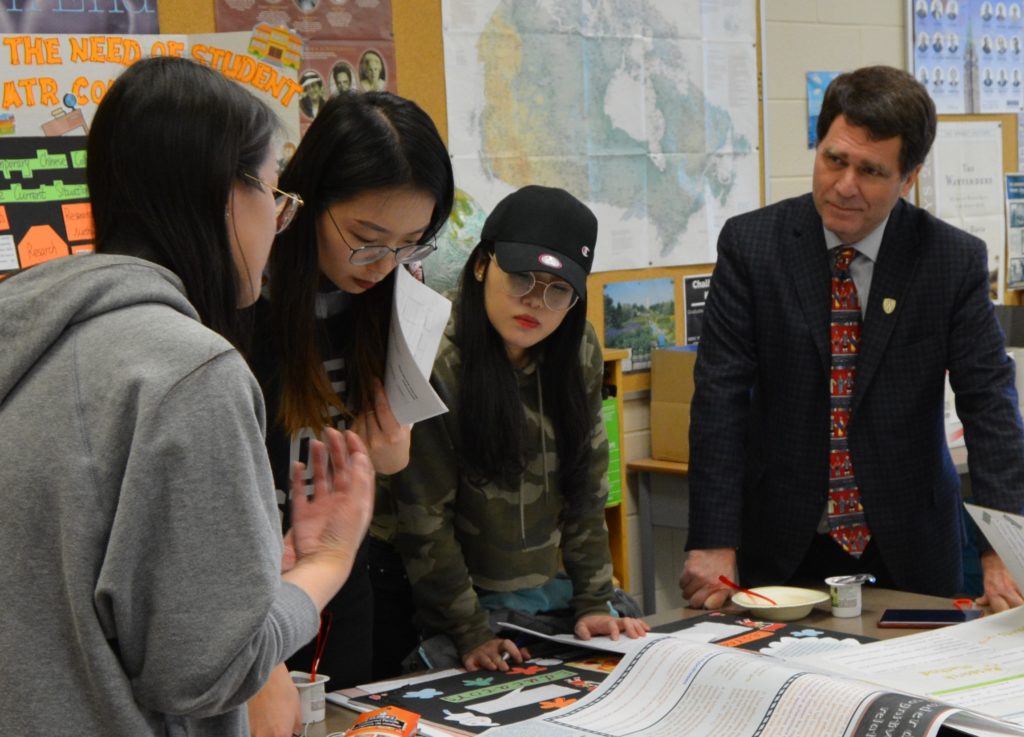
Since returning to teaching four years ago, I have focused my research in three areas. First, I have continued my career-long work in critically assessing the impact of Strategic Enrolment Management on the twin goals of achieving institutional health and student success. Second, I renewed my interest in the international student experience by exploring student perspectives on the way we teach in our colleges and universities and how we can improve our teaching of culturally and linguistically diverse international students. Third, after coauthoring two open educational resource (OER) textbooks and making increasing use of OERs in my teaching, I am beginning to focus on how we can achieve deep and interdisciplinary learning by enhancing our use of OERs.
While each of these research threads are different, it occurred to me that there is common ground between them; namely, the amplification of the student voice. If ever there was a time to pay more attention to student views, it is now. The COVID-19 Pandemic has left so many of us questioning the future. This includes students, faculty and staff, and those who lead our postsecondary educational institutions.
Psychiatrist Pavan Madan, who was also interviewed on Sunday Morning, spoke about the anxiety that is impacting us all. Dr. Madan suggests that “we put our big dreams aside for now and focus on the small, more manageable details of daily life” (Weisfogel & Ross, 2020).
So, in this public space, let me say that during the balance of the time we have in the Pandemic and for the time to follow, I will commit to amplifying the student voice in all I do.
If this interests you, consider joining me (Clayton.Smith@uwindsor.ca). I am thinking that both the journey and the destination will be quite enjoyable.
Clayton Smith
Weisfogel, A. & Ross, C. (27 December 2020). Going to Plan B: When COVID pulls the rug out from under you. Sunday Morning. New York: CBS. https://www.cbsnews.com/news/going-to-plan-b-when-covid-pulls-the-rug-out-from-under-you/?ftag=CNM-00-10aab8c&linkId=108041071
Crises as Catalysts for Transformation
At last week’s American Association of Collegiate Registrars and Admissions Officers’ (AACRAO) virtual Strategic Enrollment Management (SEM) Conference, nearly 500 attendees learned about ways to confront the crises facing colleges and universities in order to transform higher education and achieve student and institutional health.
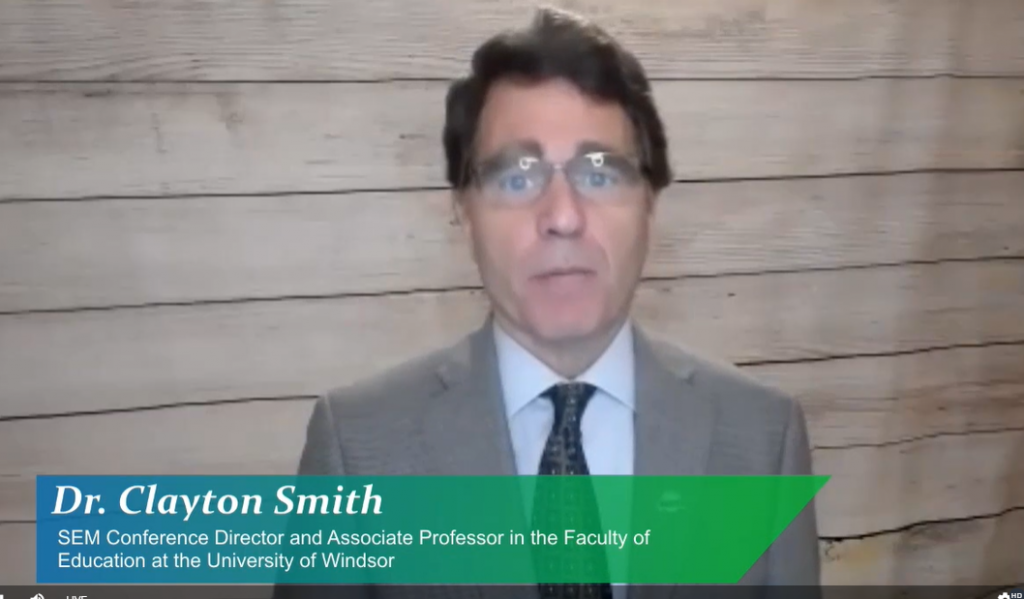
But what was even more amazing was the discussions surrounding the nexus of SEM and social justice, all with an eye toward taking action to create campus cultures that are accessible, anti-racist, and inclusive. It is one thing to acknowledge the social justice crises we face. It is something else to commit to taking action to change the face of higher education. And that is what many conference participants did.
On the third day of the conference, we engaged in panel sessions that spoke to topics like strategies for embedding equity in SEM; holistic admissions; the future of admissions; social justice, racial equality and standardized testing; and whether institutions can compete for students and cooperate to realize greater social mobility.
We also heard from Academy Award winner Matthew A. Cherry on “higher education, social justice, and equity,” in which he reflected on his personal and professional experiences to help conference participants connect with how racial equality and social justice impacts all of our lives.
Our day was capped off with a Commitment to Change facilitated by Philip Hunt, University Registrar at North Dakota State University, and performance of “Glory,” from the Academy Award-winning movie Selma by the world-renown Detroit Youth Concert Choir. We were all deeply moved.
AACRAO’s Commitment to Change reads:
“I pledge to take action by engaging in efforts at the association and on my campus that promote access, equity, inclusion, and anti-racism to provide equitable pathways for student success and support for underrepresented faculty and staff. This includes using my skills, talents and voice to serve my campus, AACRAO and our membership.”
I will be forever humbled by this incredible experience.
-Clayton Smith

Achieving Personal Mastery with SEM
In idealistic-pragmatist, Peter Senge’s The Fifth Discipline (1990), one of the five disciplines is personal mastery (the others are systems thinking, mental models, building shared vision, and team learning). Senge writes, “Organizations learn only through individuals who learn. Individual learning does not guarantee organizational learning. But without it no organizational learning occurs” (p. 139) So, for our institutions to grow, each of us must find our own path to personal mastery.
Senge describes personal mastery as “the discipline of continually clarifying and deepening our personal vision, of focusing our energies, of developing patience, and of seeing reality objectively” (Ibid, p. 7).
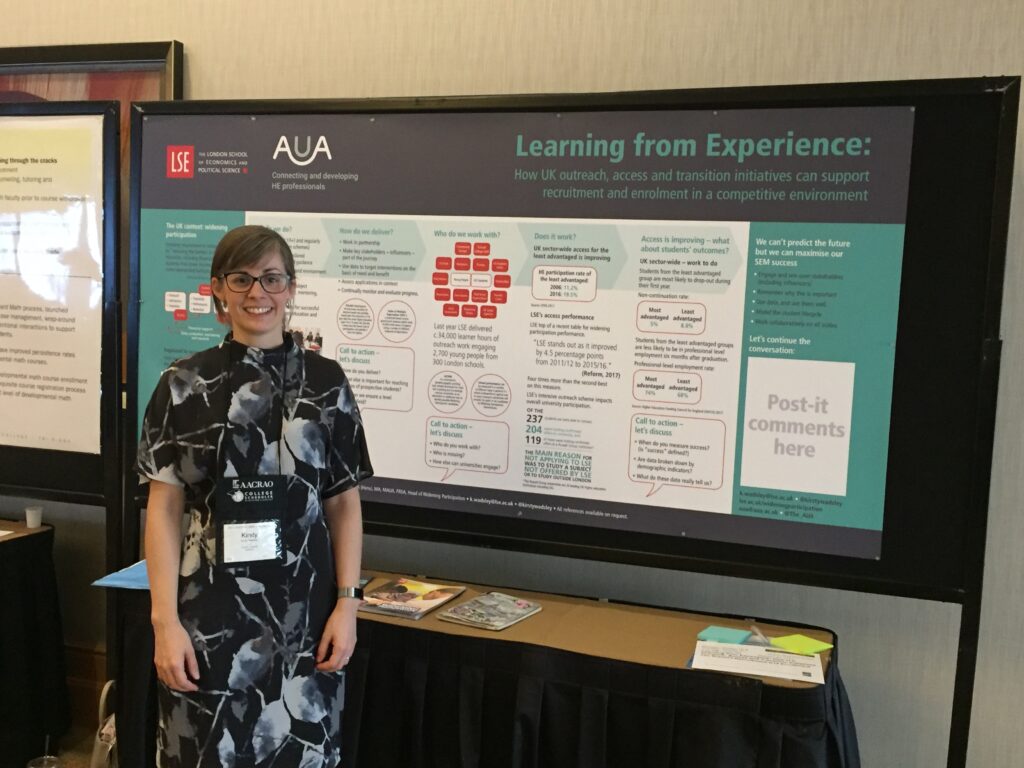
For enrollment managers, one of the ways of achieving personal mastery is through developing professional competencies and proficiencies in Strategic Enrollment Management (SEM). For those new to SEM, here is one of my favorite definitions:
Enrollment management is a comprehensive and coordinated process that enables a college [or university] to identify enrollment goals that are allied with its mission, its strategic plan, its environment, and its resources, and to reach those goals through the effective integration of administrative processes, student services, curriculum planning, and market analysis.” (Kerlin, 2008)
This can be achieved by reading some of the SEM classics and the SEM Quarterly journal, or by continuing the development of personal mastery by engaging with colleagues engaged in their own professional development.
Some will choose graduate programs or courses/experiences that culminate in a certification of some type. But for many of us, it is about coming to the AACRAO Strategic Enrollment Management Conference, which is celebrating this year its 30th conference in Las Vegas on October 25-28, 2020. Topics typically include: SEM culture, leveraging technology and data, career development, student success, and reaching optimal enrollment.
An important way to contribute to your own personal mastery in SEM is to actively participate in the conference. Currently, conference planners are promoting a Call for Proposals, where you can submit proposals for a best practice session, a poster, round-table, or a stop and share discussion on SEM hot topics, SEM research, or innovative ways institutions are implementing SEM. Proposals from multiple institutions or types of institutions are encouraged, as are proposals from Canadian and international institutions.
If you are thinking of submitting a proposal and want to discuss some ideas, send me an email at Clayton.Smith@uwindsor.ca (I am the director of the AACRAO SEM Conference!).
Whether you submit a proposal or not, let me encourage you to join us in Las Vegas this fall to enhance your personal mastery with SEM.
-Clayton Smith
Kerlin, C. (2008). Community college roadmap for the enrollment management journey. College and University, 83(4,), p. 11.
Seng. P. M. (1990). The fifth discipline The art and practice of the learning organization. New York: Currency, Doubleday.

Playing Your Position
While attending the Society for Teaching and Learning in Higher Education Conference recently, I attended a session in which Melanie Hamilton and Bonnie Farries, from Lethbridge College, spoke about the intersection of Scholarship of Teaching and Learning (SoTL) and Strategic Enrolment Management (SEM).
These are two areas that rarely find their way to the same platform, either at a professional or an academic gathering.
Hamilton and Farries introduced a model to show how each of these desparate activities support overall student and institutional success. The model they shared at the conference is below. Hamilton and Farries argued that SEM focuses on macro level decision-making without sufficient attention to the micro level and SoTL focuses on the micro level with little attention paid to macro level priorities. Through effective coordination, SEM and SoTL can enhance macro and micro activities to achieve greater levels of student success.
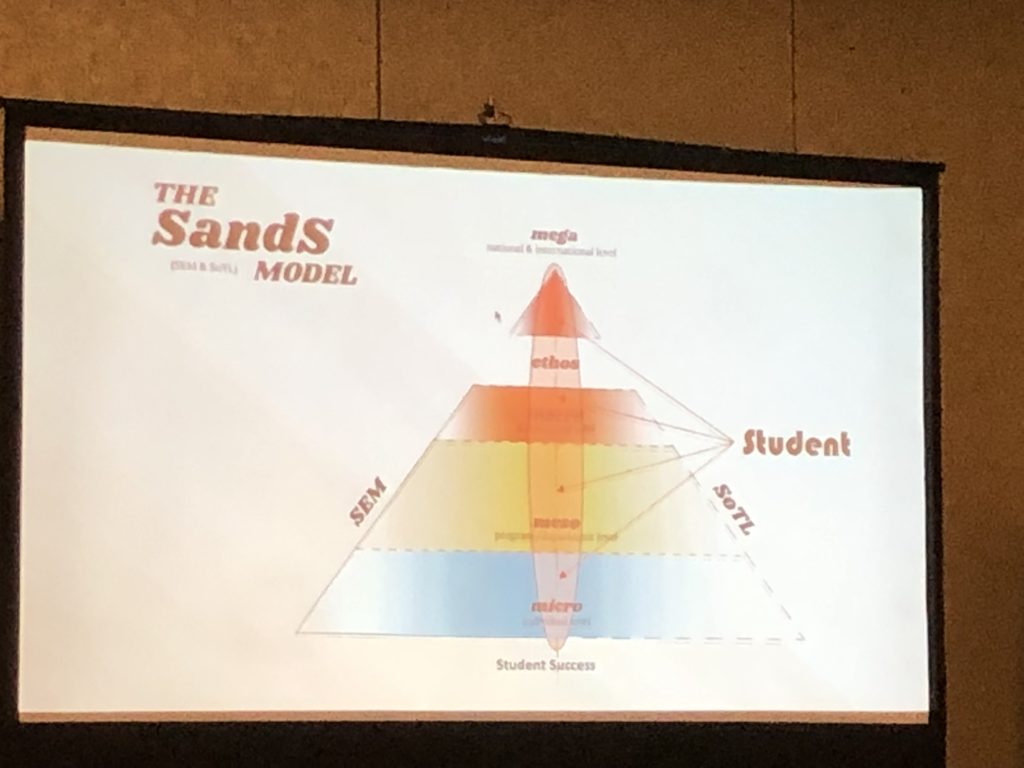
My take away is that both SoTL and SEM play an important and effective role in institutional effectiveness and student success.
The maxim of “playing your position” seems appropo to the intersection between SEM and SoTL. Many have written about the importance of playing your position within the context of team. Vince Lombardi said, “Individual commitment to a group effort–that is what makes a team work, a company work, a society work, a civilization work.” Andrew Carnegie commented, “Teamwork is the ability to work together toward a common vision. The ability to direct individual accomplishments toward organizational objectives. It is the fuel that allows common people to attain uncommon results.” And Helen Keller professed “Alone we can do so little, together we can do so much.” All could be said to endorse the notion of each of us playing our position well; that by performing our role effectively, we can achieve great things.
If enrolment professionals and the instructors who teach our classes each perform their respective roles well, it is likely that we will achieve much institutional and student success.
Clayton Smith
Providing SEM Leadership in Times of Disruption
At this week’s Canadian Strategic Enrolment Management (SEM) Summit, we discussed SEM leadership in times of disruption. We focused on how changes in institutional leadership, governments, and technologies affect SEM performance. In particular, we discussed the impact of disruption on building community and international engagement.
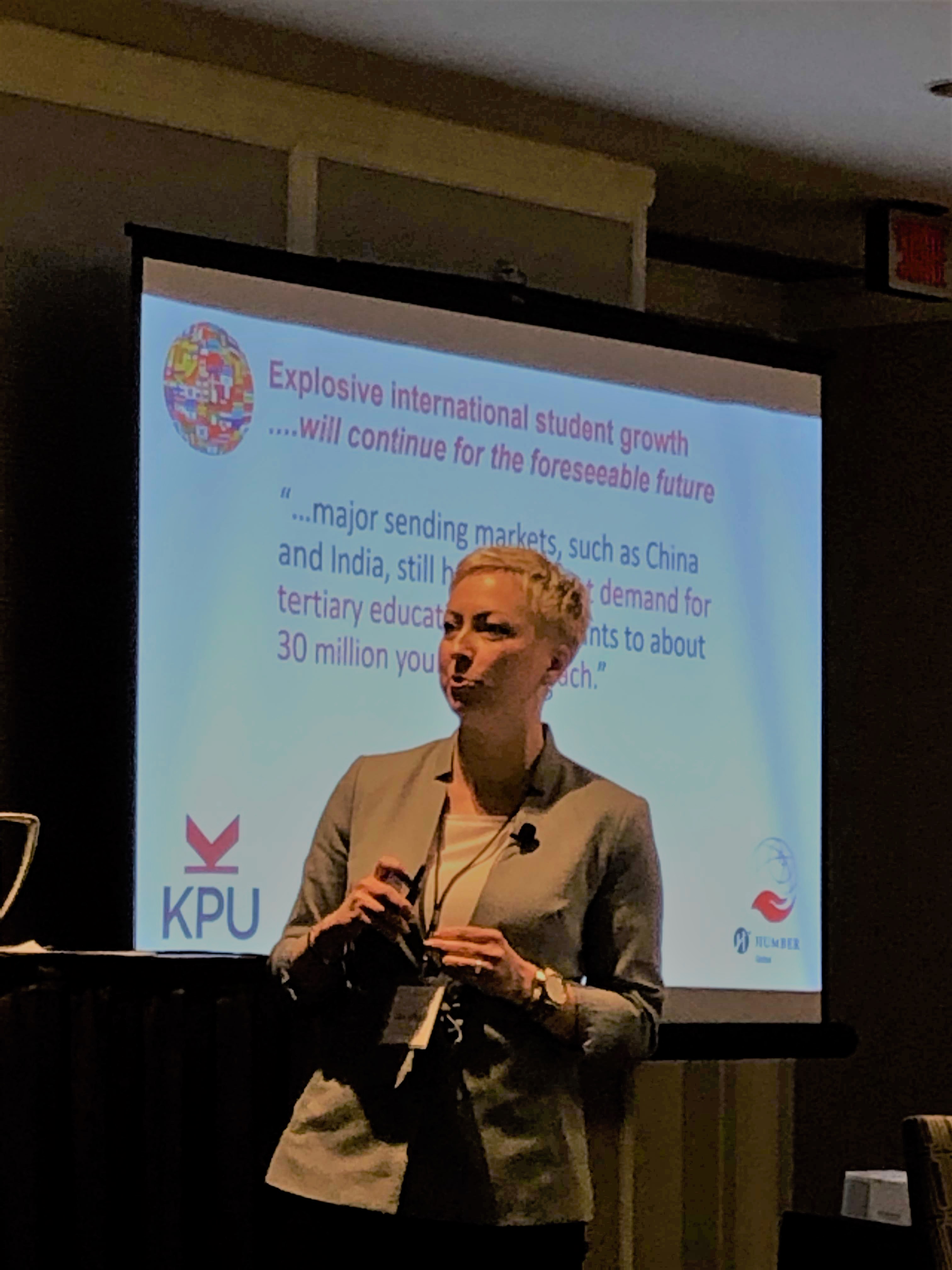
Some of our discussion points included:
- Who should be around the table when a disruption occurs? Are groups already formed, or is there a need to develop new groups?
- How do we get the data needed for decision-making? Some may already exist, but new data may also be needed.
- While disruption can leave us perplexed, we need to find ways to keep our sense of purpose while managing SEM during challenging and distracting times.
- Disruption can be an opportunity to try something new or to focus the institution more clearly on its educational values and aspirations.
- The growing challenge of maintaining data privacy and security in turbulent times.
- The opportunity disruption provides to move from competition to collaboration across the higher education sector.
For many, we are already in disruptive times in the area of international student enrolment and engagement. Some talked about the near explosion of international student enrolment in recent years, especially for students from India. We heard about how this challenge might be a way of bringing together budget and SEM; that sometimes disruption can be internal; that budget drives culture; and opportunities flow from effective brainstorming across institutional silos. We were reminded of the importance of supporting international students, both personally and academically, as they enrich our institutions.

Jason Hunter, Vice President, Student and Community Engagement, at Humber Institute of Technology and Advanced Learning put it well when he said the Summit helped us “to frame critical issues” and “to build capacity” by developing a strong SEM network of administrators and educators across Canada. We all experienced a little SEM therapy.
For me the key take away is the importance of encouraging collaborative dialogue and planning for disruption as we work to enhance institutional health and student success through our SEM work.
Feeling renewed!
Clayton Smith
Recent Comments